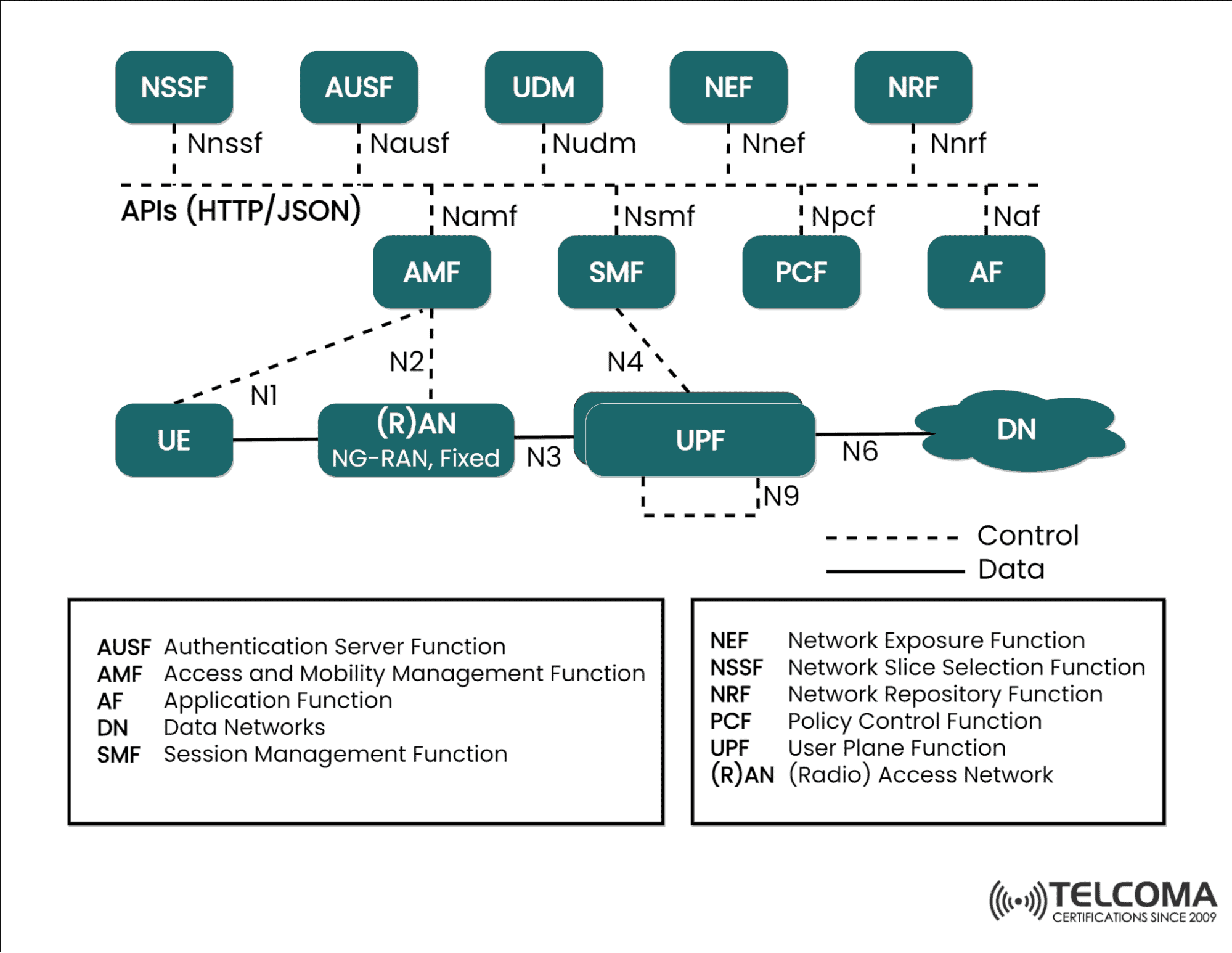5G Core Network Architecture


Introduction
5G (fifth generation) wireless technology is poised to revolutionize the telecommunications industry by offering faster data speeds, higher bandwidth, and lower latency. The 5G core network architecture is designed to support these features and provide a platform for new services and applications. In this article, we'll explore the technical details of 5G core network architecture and how it differs from the previous generations.
5G Core Network Architecture Overview

The 5G core network architecture is built on a Service-Based Architecture (SBA), which is designed to be more flexible, scalable, and efficient than the previous generations. The SBA is based on a set of network functions that can be orchestrated to provide the desired service. These network functions are called Network Functions Virtualization (NFV) and Software-Defined Networking (SDN).
The 5G core network is composed of three main components: the User Plane Function (UPF), the Control Plane Function (CPF), and the Network Slice Selection Function (NSSF). The UPF is responsible for data transmission and processing, while the CPF is responsible for controlling and managing the network. The NSSF is responsible for selecting the appropriate network slice for a given service.
The UPF
The User Plane Function (UPF) is responsible for data transmission and processing in the 5G core network. It handles the routing, forwarding, and processing of user data packets. The UPF is also responsible for enforcing quality of service (QoS) policies and performing functions such as traffic shaping and congestion control.
The UPF is designed to be highly flexible and can be deployed in various locations within the network. It can be deployed as a standalone entity, as a virtualized network function running on a cloud infrastructure, or as a distributed entity that spans multiple physical locations.
The CPF
The Control Plane Function (CPF) is responsible for controlling and managing the 5G core network. It handles functions such as network authentication, authorization, and accounting (AAA), policy management, and mobility management. The CPF is also responsible for managing network functions such as the UPF and the NSSF.
The CPF is designed to be highly scalable and can be deployed in various locations within the network. It can be deployed as a standalone entity, as a virtualized network function running on a cloud infrastructure, or as a distributed entity that spans multiple physical locations.
The NSSF
The Network Slice Selection Function (NSSF) is responsible for selecting the appropriate network slice for a given service. A network slice is a logical network that is tailored to a specific service or application. The NSSF is responsible for selecting the appropriate slice based on factors such as QoS requirements, location, and user preferences.
The NSSF is designed to be highly flexible and can be deployed in various locations within the network. It can be deployed as a standalone entity, as a virtualized network function running on a cloud infrastructure, or as a distributed entity that spans multiple physical locations.
Other Network Functions
In addition to the UPF, CPF, and NSSF, the 5G core network also includes several other network functions that are responsible for specific tasks. These functions include the following:
- Authentication Server Function (AUSF): The AUSF is responsible for authenticating users and devices in the 5G core network.
- Access and Mobility Management Function (AMF): The AMF is responsible for managing user mobility and session management.
- Policy Control Function (PCF): The PCF is responsible for managing network policies and QoS.
- Session Management Function (SMF): The SMF is responsible for managing user sessions and data flows.
- Network Exposure Function (NEF): The NEF is responsible for exposing network services to external applications and services.
Deployment Options for 5G Core Network Architecture
The 5G core network architecture is designed to be highly flexible and can be deployed in various configurations depending on the operator's requirements. The following are some of the deployment options available for the 5G core network:
- Standalone (SA): The standalone deployment option is used when the 5G core network is deployed without any dependence on the existing 4G LTE infrastructure. This option requires a complete overhaul of the network architecture and the deployment of a new radio access network (RAN).
- Non-Standalone (NSA): The non-standalone deployment option is used when the 5G core network is deployed alongside the existing 4G LTE infrastructure. This option enables operators to leverage their existing infrastructure and gradually upgrade to the 5G core network.
- Cloud-native: The cloud-native deployment option involves deploying the 5G core network on a cloud infrastructure such as OpenStack or Kubernetes. This option provides operators with the flexibility and scalability needed to meet the demands of 5G services.
- Distributed: The distributed deployment option involves deploying the 5G core network across multiple locations to improve the network's resiliency and reduce latency.
Advantages of 5G Core Network Architecture
The 5G core network architecture offers several advantages over the previous generations. These advantages include:
- Flexibility: The 5G core network architecture is designed to be highly flexible and can be deployed in various configurations depending on the operator's requirements. This flexibility enables operators to offer customized services to their customers.
- Scalability: The 5G core network architecture is designed to be highly scalable and can handle the increasing demands of 5G services. This scalability is achieved through the use of cloud infrastructure and virtualized network functions.
- Efficiency: The 5G core network architecture is designed to be more efficient than the previous generations. This efficiency is achieved through the use of network functions virtualization (NFV) and software-defined networking (SDN), which enable operators to optimize their network resources.
- Lower Latency: The 5G core network architecture is designed to offer lower latency than the previous generations. This lower latency is achieved through the deployment of the UPF closer to the edge of the network.
- Higher Bandwidth: The 5G core network architecture is designed to offer higher bandwidth than the previous generations. This higher bandwidth is achieved through the use of wider frequency bands and advanced modulation techniques.
Challenges of 5G Core Network Architecture
While the 5G core network architecture offers several advantages, it also poses several challenges. These challenges include:
- Security: The 5G core network architecture poses new security challenges that need to be addressed. The use of cloud infrastructure and virtualized network functions creates new attack vectors that need to be mitigated.
- Interoperability: The 5G core network architecture needs to be interoperable with the existing 4G LTE infrastructure to enable a smooth transition to 5G services.
- Cost: The deployment of the 5G core network architecture requires significant investment in infrastructure and resources. This investment can be a significant barrier to entry for smaller operators.
- Spectrum: The deployment of the 5G core network architecture requires access to spectrum. The availability of spectrum varies across regions, and operators need to acquire the necessary spectrum to deploy their 5G networks.
Conclusion
The 5G core network architecture is designed to support the next generation of wireless services and applications. It is built on a Service-Based Architecture (SBA) that is more flexible, scalable, and efficient than the previous generations. The 5G core network is composed of several network functions, including the UPF, CPF, and NSSF, that can be deployed in various configurations depending on the operator's requirements. The 5G core network architecture offers several advantages, including flexibility, scalability, efficiency, lower latency, and higher bandwidth. However, it also poses several challenges, including security, interoperability, cost, and spectrum.
The 5G core network architecture is still in its early stages of deployment, and it will take time for operators to fully realize the benefits of 5G services. Nevertheless, the deployment of 5G networks is expected to accelerate in the coming years, driven by the increasing demand for high-speed and low-latency wireless services and applications.
As the deployment of 5G networks continues, it is important for operators to address the challenges posed by the 5G core network architecture, including security, interoperability, cost, and spectrum. Operators need to invest in the necessary infrastructure and resources to deploy 5G networks and ensure that their networks are secure and interoperable with the existing infrastructure. They also need to work with regulators to ensure that there is sufficient spectrum available for the deployment of 5G networks.
In conclusion, the 5G core network architecture is a significant step forward in the evolution of wireless networks. It is designed to support the next generation of wireless services and applications, including virtual and augmented reality, autonomous vehicles, and the Internet of Things. While the deployment of 5G networks poses several challenges, the benefits of 5G services are expected to outweigh these challenges, providing operators with new opportunities to offer innovative services and applications to their customers.
